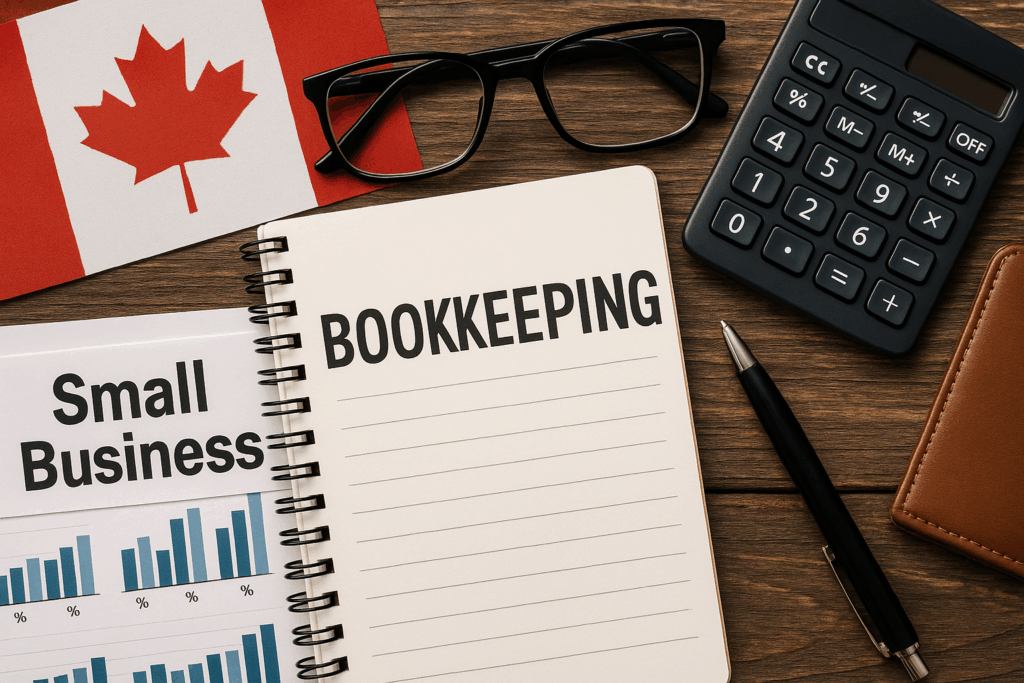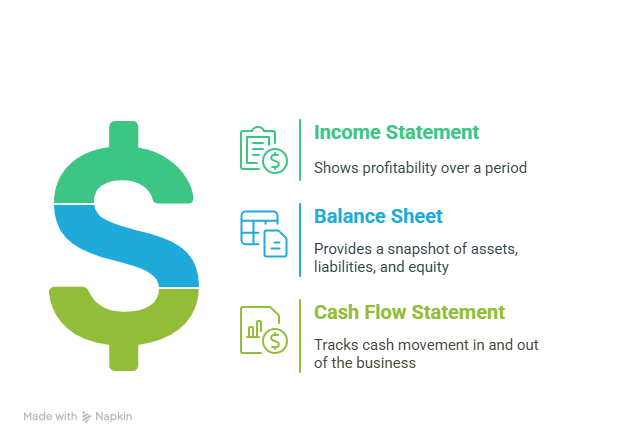Small Business Bookkeeping in Canada: A Comprehensive Guide

Running a small business in Canada comes with numerous responsibilities, and proper bookkeeping sits at the foundation of financial success. Small business bookkeeping isn’t merely about tracking expenses and income, it’s about creating a financial plan that guides business decisions, ensures tax compliance, and provides insights into your company’s financial health. Don’t know how to? Involve the experts.
For Canadian small business owners, understanding the country’s specific tax obligations and compliance requirements is particularly crucial. Proper bookkeeping helps you manage GST/HST collections and remittances, prepare accurate tax returns, and take advantage of deductions available to Canadian businesses.
The consequences of poor bookkeeping can be severe, including missed tax deadlines, overpayment of taxes, cash flow problems, and difficulty securing financing. On the other hand, a well-maintained bookkeeping system provides peace of mind and a competitive advantage through better financial intelligence.
Let’s start with understand the different aspects of bookkeeping.
Understanding Bookkeeping
What Is Bookkeeping?
At its core, small business bookkeeping involves systematically recording, organizing, and tracking all financial transactions within your business. This includes sales, purchases, payments, receipts, and any other financial activities that impact your operation.
The primary objectives of bookkeeping include the following:
- Creating an accurate record of all business transactions
- Organizing financial information for easy retrieval and analysis
- Supporting tax preparation and compliance
- Providing data for financial reporting and decision-making
- Monitoring cash flow and financial health
Bookkeeping vs. Accounting
While often used interchangeably, bookkeeping and accounting serve different functions includes:
- Bookkeeping focuses on recording day-to-day financial transactions and maintaining organized records. It’s the systematic process of collecting, organizing, and storing financial data.
- Accounting involves analyzing, interpreting, and reporting on financial data to support business decisions and planning. It transforms raw financial information into meaningful insights.
A bookkeeper typically handles transaction recording, categorization, and reconciliation, while an accountant provides financial analysis, tax planning, and strategic financial guidance.
Key Bookkeeping Terms
Understanding basic terminology will help your small business bookkeeping journey.
- Accounts Payable: Money your business owes to suppliers or vendors
- Accounts Receivable: Money owed to your business by customers
- Balance Sheet: A financial statement showing assets, liabilities, and equity
- General Ledger: The complete record of all financial transactions
- Journal Entry: The initial recording of a financial transaction
- Depreciation: Allocation of an asset’s cost over its useful life
- Capital: Money invested in the business by owners
- Revenue: Income generated from business activities
- Expense: Costs incurred to generate revenue
- Equity: Ownership interest in business assets after liabilities are deducted
Understanding these terms can help you set up your bookkeeping system.
Setting Up Your Bookkeeping System
Single-Entry vs. Double-Entry Bookkeeping
For very small businesses with simple transactions, a single-entry system might suffice. However, most Canadian businesses benefit from double-entry bookkeeping, where each transaction affects at least two accounts, creating a self-balancing system that helps identify errors.
Single-Entry Bookkeeping:
- Records each transaction once
- Similar to maintaining a checkbook register
- Tracks income and expenses only
- Suitable for very small businesses with simple finances
- Cannot produce comprehensive financial statements
- Limited error detection capability
Double-Entry Bookkeeping:
- Records each transaction as both a debit and credit
- Creates balanced books where debits equal credits
- Provides built-in accuracy verification
- Supports creation of all financial statements
- Offers better financial oversight and control
- Required for most incorporated businesses
Cash vs. Accrual Accounting
Canadian businesses must choose between two primary accounting methods:
- Cash Method: Records income when you receive payment and expenses when you pay them. This approach is simpler but may not accurately reflect business performance if there are timing gaps between services/goods provided and payment received.
- Accrual Method: Records income when earned and expenses when incurred, regardless of when money changes hands. This provides a more accurate picture of business performance over time.
The Canada Revenue Agency (CRA) allows small businesses to use either method, but the accrual method provides a more accurate picture of your business’s financial position over time. Most businesses with inventory or sales exceeding $5 million must use accrual accounting for tax purposes.
Now that you know how to set up your bookkeeping system, it’s important to know what tools to select for your work.
Selecting the Right Tools
Bookkeeping Software Options
Modern small business bookkeeping relies heavily on software solutions that streamline processes and reduce errors. Popular options in Canada include the following:
- Canadian-specific features including GST/HST tracking
- Automatic tax calculations based on province
- Integration with CRA for direct tax filing
- Multiple pricing tiers for businesses of different sizes
- Strong inventory management capabilities
- Robust reporting features
Xero:
- Cloud-based solution with strong multi-currency capabilities
- Unlimited users on all plans
- Excellent bank reconciliation tools
- Strong integration ecosystem
- User-friendly interface
- Automatic exchange rate updates for international business
Wave:
- Free accounting and invoicing software
- Canadian-based company familiar with local requirements
- Paid add-ons for payroll and payment processing
- Ideal for service-based businesses
- Unlimited receipt scanning
- Basic reporting capabilities
Sage:
- Comprehensive solution popular with Canadian accountants
- Strong inventory and project management
- Detailed audit trails
- Industry-specific solutions
- Scalable as your business grows
- Integration with Microsoft Office products
These programs automatically handle calculations, generate reports, and often integrate with banking institutions and tax filing systems particularly valuable for Canadian tax compliance.
Daily Bookkeeping Practices
Essential Financial Statements
Your bookkeeping efforts culminate in three critical financial statements described below:
Income Statement (Profit & Loss):
- Shows revenue, expenses, and profitability over a specific period
- Components include the following:
- Revenue (sales, service income, other income)
- Cost of Goods Sold (for product-based businesses)
- Gross Profit (revenue minus COGS)
- Operating Expenses (rent, utilities, payroll, etc.)
- Net Profit (gross profit minus operating expenses)
- Provides insight into operational efficiency and profitability
Balance Sheet:
- Provides a snapshot of assets, liabilities, and equity at a specific point in time
- Must balance according to the accounting equation: Assets = Liabilities + Equity
- Components include the following:
- Assets (current assets, fixed assets, intangible assets)
- Liabilities (current liabilities, long-term liabilities)
- Equity (owner’s capital, retained earnings)
- Shows business solvency and financial structure
Cash Flow Statement:
- Tracks the movement of cash into and out of your business
- Categories include the following:
- Operating activities (day-to-day business operations)
- Investing activities (purchase or sale of assets)
- Financing activities (loans, owner contributions)
- Reveals liquidity and cash management effectiveness
Additional Reports:
- Accounts Receivable Aging
- Accounts Payable Aging
- Inventory Valuation
- Sales by Product/Service
- Expense Breakdown
- Budget vs. Actual Comparison
These reports form the foundation for business analysis and planning.
Using Financial Data for Decision-Making
Regular review of financial statements helps with the following:
Profitability Analysis:
- Gross profit margin by product/service line
- Operating profit margin trends
- Comparison to industry benchmarks
- Identification of high and low-performing areas
Cash Flow Management:
- Cash conversion cycle evaluation
- Seasonality impact assessment
- Accounts receivable collection strategies
- Accounts payable optimization
- Working capital requirement projections
Growth Planning:
- Break-even analysis for new initiatives
- Investment opportunity evaluation
- Financing requirement forecasting
- Capacity utilization analysis
- Pricing strategy development
Cost Control:
- Fixed vs. variable cost analysis
- Expense trend monitoring
- Budget variance investigation
- Cost-cutting opportunity identification
- Supplier negotiation support
Tax Planning:
- Year-end tax liability estimation
- Tax deduction maximization
- Tax credit qualification assessment
- Corporate structure optimization
- Installment payment planning
Common Challenges and Solutions
1. Time Management
Many small business owners struggle to maintain consistent bookkeeping practices. Consider the following:
Time Management Strategies:
- Schedule fixed weekly bookkeeping time blocks
- Process transactions in batches for efficiency
- Use mobile apps to capture receipts immediately
- Set up automatic bank feeds to reduce manual entry
- Create templates for recurring transactions
- Implement a document management system
- Develop checklists for daily, weekly, and monthly tasks
Automation Options:
- Invoice generation and delivery
- Recurring invoice creation
- Payment reminders for overdue accounts
- Receipt capture and categorization
- Expense categorization rules
- Regular financial report generation
- Payroll processing
- Bank reconciliation
2. Avoiding Errors
Common bookkeeping mistakes include the following:
Mixing Personal and Business Finances:
- Maintain separate business bank accounts and credit cards
- Create clear policies for expense reimbursement
- Document owner’s capital contributions and withdrawals
- Properly record shareholder loans for corporations
Reconciliation Neglect:
- Schedule monthly reconciliation sessions
- Investigate all discrepancies promptly
- Maintain supporting documentation for adjustments
- Consider progressive reconciliation throughout the month
Misclassification of Transactions:
- Develop a consistent categorization system
- Create clear guidelines for transaction classification
- Review expense categories regularly
- Consider professional guidance for complex transactions
Record-Keeping Failures:
- Implement a receipt management system
- Create backup procedures for all financial data
- Follow record retention guidelines
- Develop disaster recovery plans for financial information
Tax Reporting Errors:
- Stay informed about tax obligation deadlines
- Verify tax rate configurations in your system
- Regularly review tax account balances
- Consider professional tax preparation assistance
These errors can lead to tax compliance issues and missed financial insights.
Now that you know the intricacies, let’s wrap it all up.
Conclusion
Effective small business bookkeeping is much more than a compliance requirement, it’s a powerful tool for business success. By implementing solid bookkeeping practices, choosing appropriate tools, and staying on top of Canadian tax obligations, you create a foundation for informed decision-making and financial growth.
The investment in proper financial record-keeping pays dividends through:
- Reduced tax compliance stress
- Improved financial visibility
- Better business decision-making
- Enhanced credibility with lenders and investors
- Increased business value if you ever decide to sell
- Peace of mind knowing your financial house is in order
Whether you handle bookkeeping yourself or enlist professional help, maintaining accurate financial records is non-negotiable for business success in Canada’s competitive environment.
At One Accounting, we understand the unique challenges Canadian small businesses face. Our team of experienced CPAs can help streamline your bookkeeping processes, ensure tax compliance, and provide the financial clarity needed to achieve your business goals. Contact us today to discover how our tailored solutions can support your business journey.

